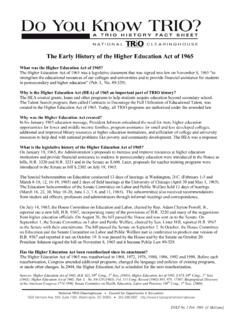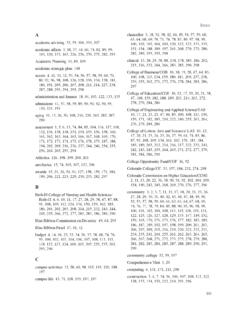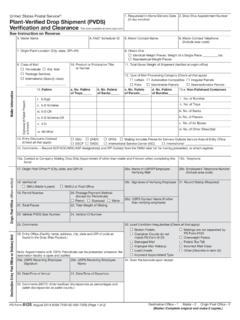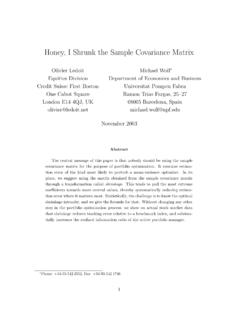Transcription of IndIcators - pellinstitute.org
1 Of higher educatiOn equity in the united StateSIndIcatorsWhen will the close the gap in higher education attainment by family income?2016 HIstorIcal trend report12%Bottom, 10%16%Second, 13%20%Third, 23%52%Top, 54%0%10%20%30%40%50%60%70%19651970197519 8019851990199520002005201020152020 Distribution by Family Income Quartile of Bachelor s Degrees Attained by Age 24: 1970 to 2014 ThirdSecondBottomTopthe pell Institute for the study of opportunity in Higher educationconducts and disseminates research and policy analysis to encourage policymakers, educators and the public to improve educational opportunities and outcomes of low-income, first generation, and students with disabilities. The Pell Institute is sponsored by the Council for Opportunity in Education (COE). The Pell Institute shares the mission of the Council to advance and defend the ideal of equal educational opportunity in postsecondary education.
2 As such, the focus of the Council is assuring that the least advantaged segments of the American population have a realistic chance to enter and graduate from a postsecondary the University of pennsylvania alliance for Higher education and democracy (pennaHead) is dedicated to advancing higher education policy and practice that fosters open, equitable, and democratic societies. Drawing on the intellectual resources of the University of Pennsylvania and a global alliance of higher education and academic leaders, PennAHEAD achieves its mission by: creating knowledge, improving practice, and building capacity. Through engagement with policymakers, institutional leaders, scholars, and practitioners, AHEAD produces research and applies research-based knowledge to address the most pressing issues pertaining to the public purposes of higher education in the and across the 16 INTRODUCTION Setting the Stage 18 EQUITY INDICATOR 1 Who Enrolls in Postsecondary Education?
3 28 EQUITY INDICATOR 2 What Type of Postsecondary Educational Institution Do Students Attend? 38 EQUITY INDICATOR 3 Does Financial Aid Eliminate the Financial Barriers to Paying College Costs? 50 EQUITY INDICATOR 4 How Do Students in the United States Pay for College? 58 EQUITY INDICATOR 5 How Does Bachelor s Degree Attainment Vary by Family Characteristics? 70 EQUITY INDICATOR 6 How Do Educational Attainment Rates in the Compare with Rates in Other Nations? 74 WHAT DOES IT MEAN? THE SEARCH FOR SOlUTIONS-S HARED DIA lOgUES ESSAYS 75 Reducing the Stratification of College Choice By laura Perna and Roman Ruiz 81 Eight Proposals to Help Inform Reauthorization of the Higher Education Act with a Focus on Financial Aid By Tom Mortenson 88 Is Higher Education a Human Right or a Competitive Investment Commodity?
4 By Margaret Cahalan, Khadish Franklin, and Mika Yamashita 98 REFERENCES 103 APPENDIX AAdditional Methodological Notes and TablesThis IndIcators of Higher Education Equity: 2016 Historical Trend Report (2016 IndIcators Report) is dedicated to Arnold Mitchem and Tom Mortenson. Without the very different work of these two individuals, the report would not have been possible. Both have dedicated their work lives to creating greater equity in educational opportunity in the United States. By producing this volume and continuing the Search for Solutions-Shared Dialogues, we honor the legacy of their work and the seeds they have sown for increasing equity of higher education opportunity in the United DeDiCationARNOlD MITCHEM & TOM MORTENSONThis report represents a collaboration between the Pell Institute for the Study of Opportunity in Higher Education (Pell Institute) of the Council for Opportunity in Education (COE) and the Alliance for Higher Education and Democracy at the University of Pennsylvania (PennAHEAD).
5 We are grateful for the contributions of many persons and organizations that made this work possible. We especially wish to thank Maureen Hoyler, Beth Hogan, Holly Hexter, and Jodi Koehn-Pike of COE for their critical support, feedback, and production support while the report was in process. We also thank Ozan Jaquette, University of Arizona, for providing use of his compiled institutional data files and for his technical assistance for their use. This report series owes much to Colleen O Brien, former Director of the Pell Institute, and author of the 2004 and 2005 IndIcators reports, and Jennifer Engle, former Pell Research Analyst, who provided analytic support for the earlier reports. Much of the trend data presented in this 2016 IndIcators Report was originally compiled by Tom Mortenson, Senior Scholar at the Pell Institute, with the assistance of Nicole Brunt, for inclusion in the Postsecondary Education Opportunity newsletters.
6 We also acknowledge the teams of government and contractor statisticians, data collectors, and data processors who have painstakingly used their technical expertise over many years to produce the estimates included in this 2016 IndIcators Report. We especially wish to thank the past and present staff from the Current Population Survey (CPS) School Surveys and American Community Survey (ACS) from the Census Bureau and past and present government and contractor staff from the High School Longitudinal Studies program, National Postsecondary Student Aid Study (NPSAS), and Integrated Postsecondary Education Data Systems (IPEDS) of the National Center for Education Statistics (NCES). We also appreciate the helpful critiques received from Susan Dynarski, Sandra Baum, and David Mundel concerning the use of CPS data and other aspects of the 2015 IndIcators we heartily acknowledge the contributions of these individuals and groups, we take full responsibility for any errors of omission or interpretation contained in this Citation: Cahalan, Margaret, Perna, Laura, Yamashita, Mika, Ruiz, Roman, Franklin, Khadish.
7 2016. IndIcators of Higher Education Equity in the United States: 2016 Historical Trend Report, Washington, DC: Pell Institute for the Study of Opportunity in Higher Education, Council for Opportunity in Education (COE) and Alliance for Higher Education and Democracy of the University of Pennsylvania (PennAHEAD).The Pell Institute and PennAHEAD would like to thank the Travelers Foundation for its financial support of the IndIcators of Higher Education Equity in the United States: 2016 Historical Trend Report and the accompanying Search for Solutions-Shared Dialogues. While we heartily acknowledge the support of Travelers, the opinions expressed in the report are those of the authors 2004 and 2005, the Pell Institute for the Study of Opportunity in Higher Education (Pell Institute), sponsored by the Council for Opportunity in Education (COE), published two editions of IndIcators of Opportunity in Higher Education.
8 In 2015 we renewed the commitment to documenting trends in higher education equity by publishing a 45-year trend report and initiated the Search for Solutions-Shared Dialogues. The current publication, IndIcators of Higher Education Equity in the United States: 2016 Historical Trend Report directly follows on these earlier efforts. This publication brings together again in partnership, the Pell Institute with the Alliance for Higher Education and Democracy of the University of Pennsylvania (PennAHEAD). Both organizations have a core mission to promote a more open, equitable, and democratic system of higher education within the United States. The Pell Institute, with its historical and ongoing ties to the federal TRIO programs, has a special mission to promote more equitable opportunity for low-income, first-generation college students, and students with disabilities.
9 Purposes of the Report. The purposes of this equity IndIcators project are: To report the status of higher education equity in the United States and to identify changes over time in measures of equity; and To identify policies and practices that promote and hinder progress; and to illustrate the need for increased support of policies, programs and practices that not only improve overall attainment in higher education but also create greater equity in higher education opportunity and outcomes. Focus on Inequities. The 2015 IndIcators Report focused on equity in higher education based on measures of family income, and this measure remains the primary focus of the 2016 edition. However, in recognition of the need to address inequity based on other demographic characteristics, the 2016 edition also includes selected tables that look at differences by race/ethnicity and family socioeconomic status (SES), an index comprised of income, education, and occupation developed by the National Center for Education Statistics (NCES) for use in the high school longitudinal Issues.
10 The 2015 IndIcators Report used Current Population Survey (CPS) data to estimate trends in bachelor s degree attainment. CPS is the only national source of yearly estimates for bachelor s degree attainment (the focus of Indicator 5), but it covers only dependent family members. It therefore has limitations for examining trends in bachelor s degree attainment by income-based quartiles due to differences in dependency patterns across income-based quartiles and changes in these patterns over time. For this 2016 edition, we have adjusted the CPS data to reflect more current estimates from the high school longitudinal studies. We present this data in the methodological Appendix A. ForeworDWe also describe trends in bachelor s degree attainment using data from the National Center for Education Statistics (NCES) Beginning Postsecondary Study (BPS) and the NCES high school longitudinal studies that have been conducted at irregular intervals approximately once per decade since the 1970s.















